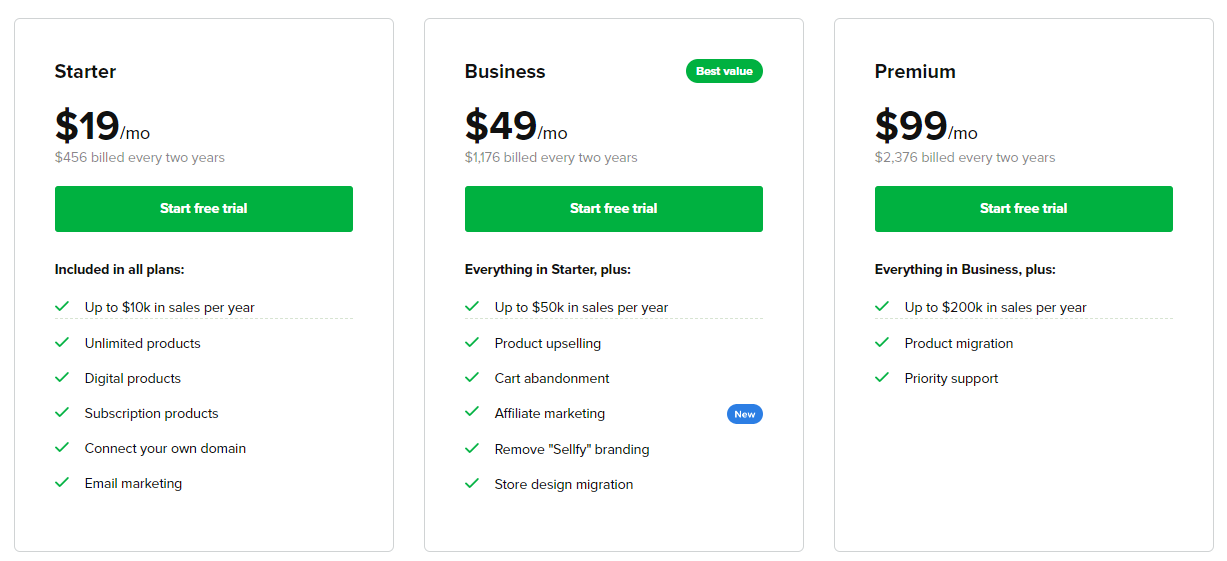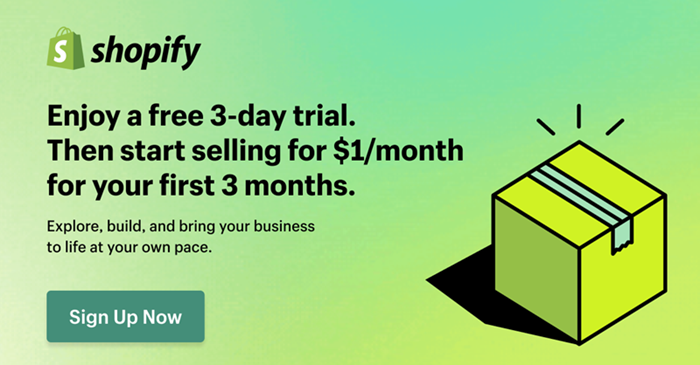My content is reader-supported by awesome people like you. Which means I could earn a commission. Learn more here!
Choosing the right platform to sell your products isn’t just about features—it’s about survival.
Do you want total control over your store, or are you willing to fight for visibility in a crowded marketplace?
Are hidden fees eating into your profits, or is convenience worth the cost?
If you’re stuck between Sellfy and Etsy,
this breakdown will expose the real trade-offs and help you decide which platform is actually right for you.
The answer might surprise you.
Side By Side Comparison
| Feature | Etsy | Sellfy |
|---|---|---|
| Best For | Handmade, vintage, and craft supplies | Digital products, subscriptions, and physical goods |
| Fees | Listing fee + 6.5% transaction fee + payment processing fees | Monthly subscription + payment processing fees (2.9% + $0.30 per sale) |
| Customization | Limited customization; must use Etsy’s marketplace format | Full control over branding and store design |
| Marketing & Exposure | Large built-in audience, but high competition | Requires self-promotion, but more control over audience |
| Product Types | Physical and digital, but strict rules for digital | Digital, subscriptions, and physical with flexible options |
| Payment Processing | Etsy Payments or PayPal | Stripe or PayPal |
| Payout Time | Typically 2–5 business days | Instant via PayPal or Stripe |
| Ease of Use | Easy to start, but follows marketplace rules | Simple setup with full control over the store |
| Overall Control | Etsy controls policies, search ranking, and visibility | Seller has full control over store, products, and pricing |
Quick Summary Of Sellfy Vs Etsy
| Should I use both? | I’d actually use both platforms to have my own store and as well market on a huge platform with proven traffic. I’ve helped clients integrate both and saw success fast even in a very saturated product. When I first started using Etsy too I was very impressed with how fast sales happened. I thought it was a great channel to sell. |
| Are we getting free trials for both? | Sellfy totally does and then you can just use Etsy standard for free. |
| Customer service | I’d say both hit the OK customer service route. |
| How easy to get started | Both make it quite simple to get started without really any huge obstacles, minus of course, getting comfortable with the platform |
| My Verdict | Overall, they both are going to allow you to sell. Sellfy is in my opinion, your platform to implement on to all the social media locations. I’d call it the hub. You’re going to control your products from here and strategies will start from here. I’d say Etsy is a great spot to sell. I look at it as a great sales channel that complements you’re overall objective. To get seen and make sales. Bottom line these platforms complement each other in their own ways. Use both! |
How I Like To Test These Platforms
| Ease of use | Is it easy to sign up for, and is guidance there to not fail |
| Customer Support | I gotta see this somehow. We gotta get that help when we need it. |
| Tools it offers (Marketing, SEO, Product Tools) | We need tools without venturing out to other companies all the time |
| 25-point feature checklist | It can be my secret sauce. It includes other areas but it lets me know how it’s doing. |
| Actual customer user ratings | I set out and find actual other users that use this product for their business. These can be on review sites, forums, or my reader’s opinions to give you an idea. |
| Testing project | I try to run it through a project I feel good about |
| Overall rating | After compiling data, I give it a rating. |
Ratings Breakdown Summary
| Sellfy Vs Etsy On Ratings | Sellfy | Etsy |
| Ease of use | 4.5 out of 5 | 4.5 out of 5 |
| Customer Support | 4.5 out of 5 | 4.2 out of 5 |
| Tools it offers (Marketing, SEO, Product Tools) | 4.4 out of 5 | 4.2 out of 5 |
| 25-point feature checklist | 4.4 out of 5 | 4.4 out of 5 |
| Testing project | 4.6 out of 5 | 4.6 out of 5 |
| Customer User Rating Score | 4 out of 5 based on 43 Users | 1.0 out of 5 based on 1,583 (Seems low to me) |
| Overall Rating | 4.4 out of 5 | 3.82 out of 5 |
Pros and Cons Of Each One

Sellfy steps into the eCommerce scene with a focus on digital products, physical goods, and subscriptions.
Let’s break down what makes it tick and what could be better.
Pros and Cons of Sellfy
Pros
- Straightforward Setup: Dive into Sellfy with ease. It’s user-friendly, making setting up shop a breeze.
- Customization Galore: Sellfy hands the reins over to you with its customization options, letting your brand’s personality shine bright.
- No Extra Fees on Sales: You keep more of your earnings because Sellfy doesn’t take a cut from your sales, aside from standard payment processing fees.
- Marketing Tools Included: Boost your business from the get-go with built-in marketing tools, a big plus for expanding your reach.
Cons
- Subscription Costs: To tap into what Sellfy offers, there’s a subscription fee. It requires an upfront investment, which might be a hurdle for some.
- Less Organic Traffic: Sellfy doesn’t have the same built-in audience as a marketplace like Etsy. You’ll need to hustle a bit more for visibility.
Pros and Cons of Etsy
Etsy shines as a global marketplace for handmade, vintage, and unique goods.
Here’s the scoop on its strengths and areas where it could be a bit limiting.
Pros
- Huge Built-in Audience: Etsy brings the customers to you, thanks to its vast marketplace.
- Sense of Community: Find support and camaraderie among Etsy’s massive network of creative sellers.
- Easy to Launch: Getting your Etsy shop off the ground is quick and painless, perfect for beginners.
- Niche Market Appeal: Ideal for selling unique, handmade, or vintage items.
Cons
- Fees: Listing and transaction fees can add up, so you’ll need to price your products accordingly.
- Competition: With so many sellers, standing out in the Etsy marketplace requires extra creativity and marketing effort.
What’s the Scoop on Sellfy?
Sellfy positions itself as a sleek, user-friendly platform primarily for digital creators, but don’t let that fool you – it also supports the sale of physical goods and subscriptions.
Features to Love:
- Ease of use: Setting up shop is straightforward. If you’re familiar with basic web functions, you’re golden.
- Customization: Your store, your rules. Sellfy offers extensive customization, allowing your brand identity to shine.
- No extra fees: Sellfy doesn’t take a cut of your sales. The price you set is the price you get, minus payment processing fees.
- Built-in marketing tools: From email marketing to upselling, Sellfy hands you the tools to grow your business right out of the gate.
Sounds pretty sweet, right? Keep in mind, though, Sellfy requires a subscription, so it’s a bit of an investment.
You’ll want to make sure you’re ready to dive in and take full advantage of its features.
And Then There’s Etsy
Etsy is like that trendy local market where artisans and vintage seekers gather.
It’s well-loved for its vast, enthusiastic community and the unique, often handmade items that fill its virtual shelves.
Features to Love:
- Massive audience: Etsy brings the customers right to your doorstep. Its platform hosts millions of buyers looking for something special.
- Community support: The sense of community here is strong. You’ll find forums, teams, and events all designed to connect like-minded sellers and buyers.
- Ease of getting started: You can set up your Etsy shop in the afternoon and start listing items right away.
- Focus on unique items: Etsy really shines for those selling handmade, vintage, or exceptionally unique items.
However, Etsy does take a cut of your sales through listing and transaction fees, so factor that into your pricing strategy.
Let’s Check Out The Pricing Plans
Let’s dive into the pricing plans for Sellfy and Etsy, two big names in the online retail space.
My aim is to give you a clear, easy-to-grasp breakdown of what each platform offers and at what cost.
So, whether you’re a budding designer or a seasoned creative looking to expand your online presence, this overview’s got you covered.
Let’s unlock the details of Sellfy’s pricing plans
The Starter Plan
Let’s kick things off with Sellfy’s Starter Plan. Imagine you’re taking your very first step into the vast world of eCommerce. This plan’s got your back!
- Price: $19 per month
- What’s in it for you: You get your own store, where you can sell up to 10k worth of your products in a year. Plus, you can rock unlimited products – both digital and physical. Cool, right?
- Who it’s perfect for: If you’re just dipping your toes into the eCommerce waters, this plan could be your best bud.
The Business Plan
Moving on, let’s chat about the Business Plan. It’s like the Starter Plan’s older, cooler sibling who knows a bit more about the world.
- Price: $49 per month
- What’s in it for you: You can sell up to 50k of your fantastic products annually, plus all the goodies from the Starter Plan. But wait – there’s more! You also get email marketing tools to chat with your customers directly.
- Who it’s perfect for: Got a vibe your store’s about to take off? This plan is for those who feel the starter plan is a tad tight and want more room to grow.
The Premium Plan
Ah, the Premium Plan. It’s like stepping into the VIP section where things start to get seriously awesome.
- Price: $99 per month
- What’s in it for you: Now we’re talking big – sell up to 200k in a year. You get everything from the Business Plan, plus you can remove Sellfy branding from your store. It’s like getting the keys to your castle.
- Who it’s perfect for: If your shop’s booming and you’re all about giving your brand that sparkling shine, this is your golden ticket.
The Enterprise Plan
For those who laugh in the face of limits, the Enterprise Plan is your heavyweight champion.
- Price: Need to chat with Sellfy directly for this one.
- What’s in it for you: It’s custom. That means whatever you need, you talk it out with Sellfy, and they tailor-make a plan just for you. Sky’s the limit – or maybe not even.
- Who it’s perfect for: If you’re soaring high and need something as unique as your business, this is where you belong.
Etsy Pricing
Now, onto Etsy. It’s a go-to for artists, crafters, and vintage lovers.
Etsy’s pricing structure is quite different, focusing more on listing fees and transaction costs rather than a monthly subscription model.
- Listing Fees
- Price: $0.20 per listing
- Etsy charges you this fee every time you list or renew a product, and each listing lasts for four months.
- Transaction Fees
- Price: 5% of the selling price
- When you make a sale, Etsy takes a 5% cut of the total item cost (including shipping price set by you).
- Payment Processing Fees
- These fees vary based on the country of the seller’s bank. In the US, for example, it’s 3% + $0.25 per transaction.
Etsy Plus Pricing
The monthly fee for Etsy Plus is $10.
This subscription is an upgrade from the standard, free Etsy account, giving sellers more features to enhance their shops.
Features of Etsy Plus
Etsy Plus provides several key features to subscribers:
- Monthly Credits: Subscribers receive 15 free listing credits each month, which can save money for active sellers. Additionally, Etsy Plus provides a $5 Etsy Ads credit monthly, which can help increase the visibility of your products.
- Customization Options: Etsy Plus allows for greater customization of your shop. This means you can make your storefront more appealing and unique, standing out from the competition.
- Discounts on Domain Names: Etsy Plus members can purchase a custom .com domain (or other endings) for their shop at a discount. This is crucial for branding and making sure your shop is easily recognizable and professional.
- Restock Requests: This feature lets shoppers request to be notified when an out-of-stock item is back in stock, which can lead to quick sales once you replenish popular items.
- Advanced Shop Sections: With Etsy Plus, you get more options to organize your shop’s listings, making it easier for customers to browse and find what they’re looking for.
- Discounts and Perks: Etsy Plus subscribers get a 30% discount from Moo, an online print and design company. This can be beneficial for creating custom business cards and other promotional materials at a lower cost.
Etsy Plus is designed for sellers who are ready to invest a little more into their shop for additional growth opportunities.
The monthly listing and ad credits can help reduce costs, while customization options and promotional discounts support branding and marketing efforts.
Considering these features, Etsy Plus could be a valuable investment for sellers looking to optimize their shop’s appearance and reach a larger audience.
Some Thoughts On Pricing
Etsy makes a lot of sense for small-scale artisans and creatives because it gives you access to a massive, engaged audience without the upfront costs of a monthly plan.
However, the fees can start to eat into profits if you’re not careful, and because the marketplace is so vast, standing out can sometimes be a challenge.
In comparing the two, Shopify leans more toward providing a comprehensive platform geared for growth and scaling, with a cost structure that supports this.
Etsy, with its lower initial costs, serves those looking to test the waters or operate on a smaller scale.
Each has its perks and quirks, so choosing the right platform really comes down to your business model, growth aspirations, and how much control you want over the branding and customer experience.
FAQ For Sellfy And Etsy
What are the key differences between Sellfy and Etsy?
Sellfy functions primarily as an ecommerce platform for creators who wish to sell digital, physical, and subscription-based products straight from their own store. On the flip side, Etsy is a well-known marketplace that specializes in handmade, vintage, and craft supply goods. With Etsy, you're setting up shop in a bustling online market, while Sellfy gives you the toolset to build and manage a standalone storefront.
How does product listing work on Sellfy compared to Etsy?
On Etsy, you list items individually and they appear in a marketplace among other sellers' offerings. You're subject to listing fees and the competition is visible right next to your products. In contrast, Sellfy allows you to list unlimited products without an extra fee and focuses on presenting your brand solo, without immediate direct comparisons to competitors within the platform.
Can I customize my storefront on Sellfy and Etsy?
Absolutely! Etsy provides options for branding your shop within their marketplace framework. You can add a banner, profile photo, and arrange your listings to reflect your brand style. Sellfy steps it up by offering comprehensive customization tools to modify your storefront to echo your brand's design language, making it possible to construct a cohesive and branded shopping experience from start to finish.
Which platform is better for digital products, Sellfy or Etsy?
If your inventory leans towards digital products—think ebooks, music, or software—Sellfy might be your go-to. Sellfy is optimized for digital sales, offering features like instant downloads, PDF stamping, and video streaming. Etsy can accommodate digital product sales, but it's more of a secondary feature rather than a primary focus.
What are the commission and fee structures for Sellfy vs Etsy?
Etsy is known for its transaction fees, listing fees, and payment processing fees, which can add up, especially for smaller transactions. Sellfy, conversely, operates on a subscription model, where you pay an annual or monthly fee dependent on your sales volume, with zero transaction fees on top. This means as your sales grow, your expenses with Sellfy don't inherently spike.
How does payment processing work on Sellfy compared to Etsy?
Sellfy offers direct PayPal and Stripe integration, which facilitates swift and seamless payments straight to your account. Etsy processes payments through their own Etsy Payments system but also offers PayPal. It's worth noting that Etsy's system consolidates your sales funds before disbursing them according to your set schedule, which can sometimes lead to slight delays in receiving payments.
Can I sell internationally on both Sellfy and Etsy?
You sure can. Both platforms empower you to reach a global audience. Etsy has a vast international customer base actively browsing their site, while Sellfy provides the tools to sell worldwide, although you'll need to drive your own traffic. Remember, attention to localization and international shipping strategies is key on both platforms.
How do customer interactions differ between Sellfy and Etsy?
Etsy's marketplace setup naturally encourages customer interaction through reviews, Q&A, and a direct messaging system. Sellfy facilitates customer communication as well, but its solitary storefront model means that interaction is more controlled and funneled through the tools and integrations you set up.
Which platform is easier for beginners to set up, Sellfy or Etsy?
For beginners, Etsy might be the more straightforward route. It's a simple, guided process to set up shop within their marketplace with lots of support and community resources available. Sellfy requires a bit more tech-savviness, as you're essentially building a store from the ground up, but don't fret—it offers a user-friendly interface and robust documentation.
My Full Verdict
So, how do you decide which platform is the one to go with
Consider these points:
- What are you selling? Digital products or a mix of digital and physical? Go Sellfy. Handmade or vintage? Etsy’s your stage.
- Brand identity: If having complete control over your shop’s look and feel is crucial, Sellfy offers more customization options.
- Budget: Starting with minimal overhead? Etsy’s pay-as-you-go model might be more attractive. Ready to invest in your business’s growth from the get-go? Check out what Sellfy offers.
In my experience, both platforms have their sweet spots.
Sellfy gives you that professional, branded store feeling, while Etsy connects you with a broad, engaged audience eager for unique finds.
Ultimately, your choice comes down to your specific needs, your products, and how you want to connect with your customers.
Whether you choose Sellfy, Etsy, or even both, you’re taking a step towards sharing your creativity with the world.
And that’s what really matters.
I’ll tell you what from my experience at the end of the day I’m getting on both of these platforms.
The Etsy sales channel is solid and Sellfy is going to be you’re hub to sell and start at.






Leave a Reply